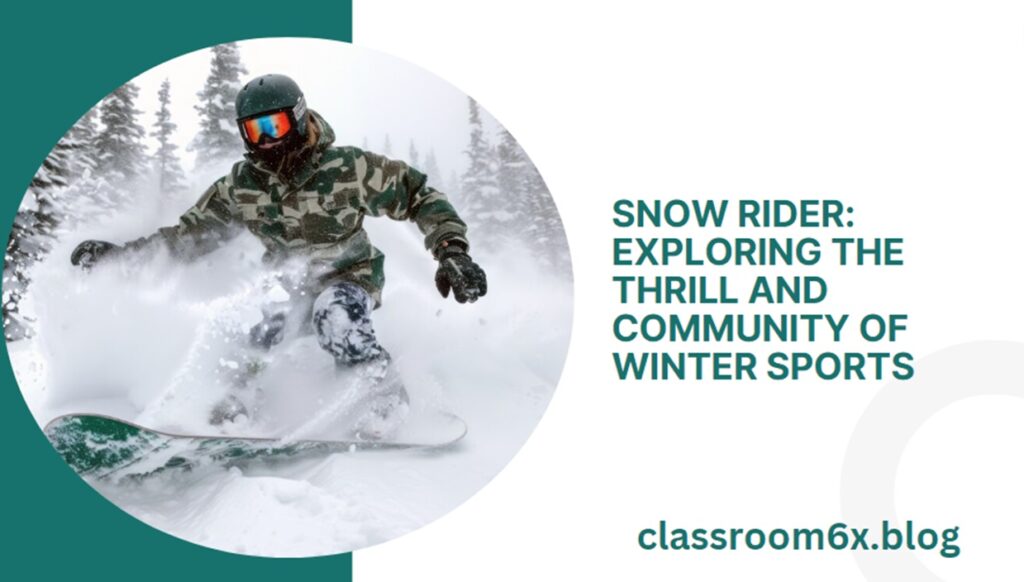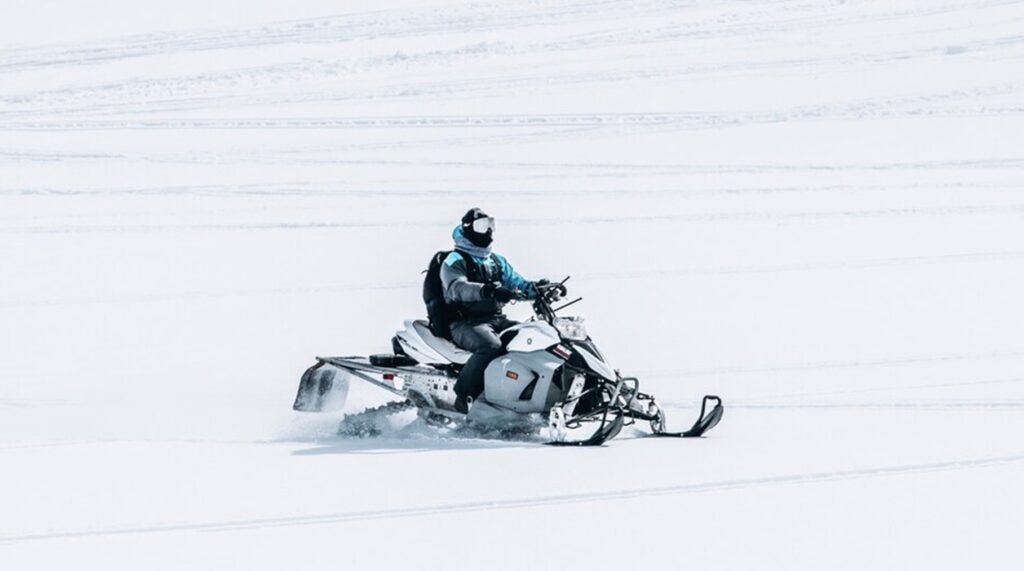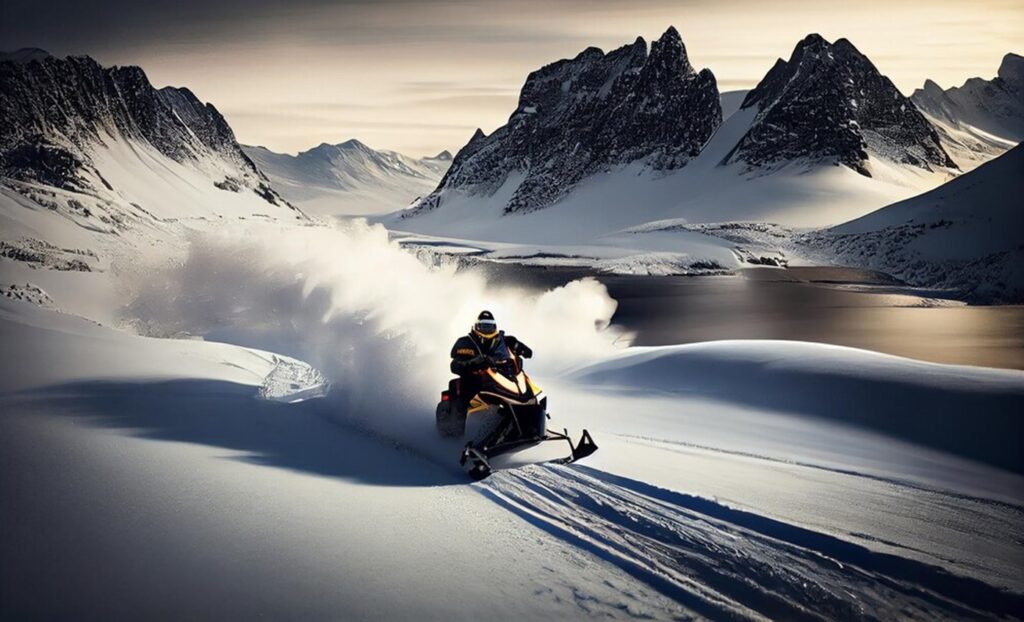
snow rider
Introduction: Snow Rider:
The term “snow rider” evokes images of exhilaration, adventure, and the pristine beauty of snow-covered landscapes. Snow riders are individuals who embrace the winter months with a passion for gliding, carving, and maneuvering through the snow on skis, snowboards, or other innovative equipment. This article delves into the multifaceted world of snow riding, exploring its origins, the various forms it takes, the culture surrounding it, and the profound connection it fosters between riders and the winter wilderness.
Table of Contents
The Genesis of Snow Riding
Historical Roots
Snow riding has a deep-seated history that dates back thousands of years. The earliest skis, found in northern Russia, are over 8,000 years old, initially used for practical purposes like hunting and transportation. In Scandinavia, skiing began to evolve into a recreational activity in the 19th century, with Norway hosting the first organized ski competitions.

Snowboarding is a more recent development, born in the 1960s and 70s in the United States. The Snurfer, invented by Sherman Poppen in 1965, is often regarded as the precursor to the modern snowboard. Snowboarding’s popularity surged through the 1980s and 90s, culminating in its inclusion in the Winter Olympics in 1998.
Technological Evolution
The evolution of snow riding equipment has been marked by significant technological advancements. Modern skis and snowboards are crafted from high-tech materials such as carbon fiber and advanced composites, making them lighter, stronger, and more flexible. Innovations in bindings, boots, and protective gear have enhanced performance and safety, enabling riders to push the limits of the sport.
Diverse Forms of Snow rider
Alpine Skiing
Alpine skiing, also known as downhill skiing, is the most traditional form of snow riding. It involves descending a snow-covered slope on skis that are fixed to specialized boots. Alpine skiing encompasses a variety of terrains, from gentle groomed runs to steep, challenging slopes, and includes competitive disciplines such as slalom, giant slalom, and downhill racing.
Snowboarding
Snowboarding combines elements of surfing, skateboarding, and skiing. Riders stand sideways on a single board, navigating down the slope by shifting their weight and using the board’s edges. Snowboarding styles include freestyle, focusing on tricks and jumps; freeride, emphasizing natural terrain; and alpine, involving racing on hard-packed snow.
Nordic Skiing
Nordic skiing includes cross-country skiing and ski jumping. Cross-country skiing involves traversing flat or gently rolling terrain with long, narrow skis and a gliding motion. It is both a competitive sport and a popular recreational activity in snow-covered regions. Ski jumping involves launching off a ramp and aiming for the longest jump, judged on distance and style.
Telemark Skiing
Telemark skiing is a blend of alpine and Nordic skiing, characterized by a unique binding system that leaves the heel free. This allows for a distinctive lunging turn, combining the speed and agility of alpine skiing with the grace and endurance of cross-country skiing. Telemark skiing has a dedicated following, appreciated for its blend of technique and freedom.
Freestyle and Freeride
Freestyle skiing and snowboarding involve performing tricks, jumps, and aerial maneuvers on specially designed terrain parks featuring rails, boxes, and halfpipes. Freeride focuses on riding natural, ungroomed terrain, often in remote backcountry locations. Both disciplines emphasize creativity, skill, and an adventurous spirit.
The Thrill of Being a Snow Rider

Adrenaline and Flow
One of the primary attractions of snow riding is the adrenaline rush it provides. The sensation of gliding down a snow-covered slope, the wind rushing past, and the excitement of navigating through trees or over jumps create an unparalleled sense of freedom and exhilaration. This rush is often described as a state of flow, where riders become completely absorbed in the moment, their movements fluid and instinctual.
Connection with Nature
Snow riding offers a unique opportunity to connect with nature. The pristine beauty of snow-covered mountains, the crisp, clean air, and the silence of a winter landscape create a serene and awe-inspiring environment. For many, snow riding is not just a sport but a way to experience the majesty of the natural world in its most tranquil and untouched state.
Physical and Mental Benefits
Snow riding is a physically demanding activity that engages multiple muscle groups, improves balance and coordination, and provides an excellent cardiovascular workout. It also has numerous mental benefits, including stress relief, improved mood, and enhanced mental clarity. The combination of physical exertion and the meditative quality of gliding through snow can be profoundly therapeutic.
Social Bonding
Snow riding is often a social activity, bringing together friends, families, and communities. Ski resorts and snow parks are vibrant social hubs where people of all ages and backgrounds come together to share their passion for the sport. The camaraderie and shared experiences on the slopes create lasting bonds and a strong sense of community.
The Culture of Snow Riders
Iconic Ski Resorts
Ski resorts are the heart of snow riding culture, offering a range of amenities and activities for riders of all levels. Iconic destinations like Aspen, Whistler, Chamonix, and St. Moritz attract enthusiasts from around the world. These resorts provide meticulously groomed runs, challenging backcountry terrain, and luxurious accommodations, catering to both recreational riders and elite athletes.
Competitive Spirit
Competitive snow riding has a rich tradition, with events ranging from local competitions to international championships. The Winter Olympics is the pinnacle of competitive snow sports, featuring alpine skiing, snowboarding, freestyle skiing, and more. Other major events include the X Games, FIS World Cup, and Red Bull competitions, showcasing the best talent and pushing the boundaries of what is possible in the sport.
Media and Pop Culture
Snow riding has a significant presence in media and pop culture. Films, documentaries, and television shows capture the excitement and beauty of the sport, inspiring new generations of riders. Snowboarding and skiing video games have also become popular, offering virtual experiences of the thrill of the slopes. Additionally, social media platforms allow riders to share their adventures, tricks, and tips, fostering a global community of snow enthusiasts.
Environmental Awareness
As snow riding relies heavily on natural snow conditions, the community is acutely aware of environmental issues such as climate change and sustainability. Many ski resorts and organizations are taking steps to reduce their environmental impact, promoting eco-friendly practices and supporting conservation efforts. Riders themselves often advocate for sustainable practices, recognizing the importance of preserving the natural landscapes they cherish.
Getting Started as a Snow Rider

Choosing the Right Equipment
Selecting the appropriate equipment is crucial for a safe and enjoyable snow riding experience. Beginners should seek advice from experienced riders or professionals to choose the right skis or snowboard, bindings, boots, and protective gear. Renting equipment initially can be a cost-effective way to try out different styles and find what suits best.
Learning the Basics
Taking lessons from a certified instructor is highly recommended for beginners. Lessons provide essential skills and techniques, ensuring a solid foundation and reducing the risk of injury. Many ski resorts offer beginner packages that include lessons, equipment rental, and lift tickets, making it easier for newcomers to get started.
Safety Precautions
Safety is paramount in snow riding. Wearing a helmet and other protective gear is essential, as is understanding the rules of the slopes and respecting other riders. Checking weather conditions, staying within designated areas, and being aware of potential hazards such as avalanches are critical for a safe experience. For those venturing into backcountry areas, carrying avalanche safety equipment and knowing how to use it is vital.
Physical Preparation
Snow riding is physically demanding, so preparing the body through regular exercise and conditioning can enhance performance and prevent injuries. Strengthening the core, legs, and improving cardiovascular fitness are particularly beneficial. Flexibility and balance exercises, such as yoga or pilates, can also improve agility and control on the slopes.
Advanced Techniques and Styles
Carving and Turning
Carving and turning are fundamental skills in both skiing and snowboarding. Carving involves making clean, precise turns by engaging the edges of the skis or snowboard. This technique allows for greater control and speed. Advanced riders master different types of turns, such as the dynamic parallel turn in skiing or the Euro carve in snowboarding, enhancing their ability to navigate various terrains.
Jumps and Tricks
Freestyle snow riding involves performing jumps, spins, grabs, and other tricks. This style requires a combination of skill, creativity, and bravery. Terrain parks are designed to facilitate freestyle riding, with features like jumps, rails, and halfpipes. Learning to perform tricks safely involves starting with basic maneuvers and progressively attempting more complex ones under the guidance of experienced riders or coaches.
Backcountry and Off-Piste Riding
Backcountry and off-piste riding involve exploring ungroomed, natural terrain away from the main slopes. This style offers a sense of adventure and solitude but comes with increased risks, such as avalanches and difficult terrain. Advanced knowledge of snow conditions, navigation, and avalanche safety is essential. Many riders take backcountry courses to gain the skills needed for safe exploration.
Racing and Competition
For those with a competitive spirit, snow riding offers numerous opportunities to race and compete. Alpine ski racing, snowboard cross, and slopestyle are just a few examples. Competitive riders undergo rigorous training to refine their techniques, build endurance, and develop strategies. Participating in competitions can be a rewarding way to challenge oneself and connect with the broader snow riding community.
The Future of Snow rider
Innovations and Trends
The future of snow riding looks promising, with ongoing innovations in equipment, technology, and training methods. Advances in materials science continue to produce lighter, stronger, and more responsive gear. Wearable technology, such as smart helmets and performance-tracking devices, is becoming more common, offering riders new ways to monitor and improve their skills.
Sustainability Initiatives
As the impacts of climate change become more apparent, the snow riding community is increasingly focused on sustainability. Ski resorts are implementing green energy solutions, reducing waste, and promoting eco-friendly practices. Additionally, organizations are advocating for policies and initiatives to combat climate change, ensuring that future generations can enjoy the beauty and thrill of snow riding.
Expanding Accessibility
Efforts are being made to make snow riding more accessible to diverse populations. Programs that provide affordable equipment rental, lessons, and lift tickets aim to introduce the sport to underrepresented communities. Adaptive snow riding programs also support individuals with disabilities, offering specialized equipment and training to ensure everyone can experience the joy of the slopes.
Conclusion: Snow rider
Being a snow rider is more than just a winter activity; it’s a lifestyle and a passion shared by millions around the world. From its rich history to its diverse forms and the sheer thrill it offers, snow riding captures the imagination and hearts of those who partake in it. Whether carving down a groomed slope, performing tricks in a terrain park, or exploring backcountry terrain, snow riding provides an unparalleled sense of freedom and adventure. As the community continues to innovate and embrace sustainability, the future of snow riding looks brighter than ever. So, strap on your skis or snowboard, head to the mountains, and discover the magic of being a snow rider.
FAQ about Snow rider
- What is a snow rider? A snow rider is someone who enjoys winter sports like skiing or snowboarding, navigating snow-covered slopes and terrain.
- What equipment do I need to start snow riding? Essential equipment includes skis or a snowboard, boots, bindings, a helmet, and appropriate winter clothing.
- Is snow riding safe for beginners? Yes, with proper instruction, equipment, and safety precautions, snow riding can be safe and enjoyable for beginners.
- Where can I learn snow riding? Many ski resorts offer lessons for beginners, with professional instructors to help you learn the basics and improve your skills.
- What are the benefits of snow riding? Snow riding offers physical benefits like improved fitness and balance, mental benefits such as stress relief, and a unique connection with nature.






